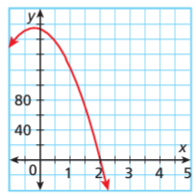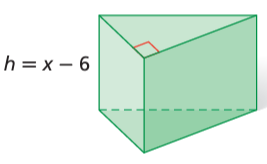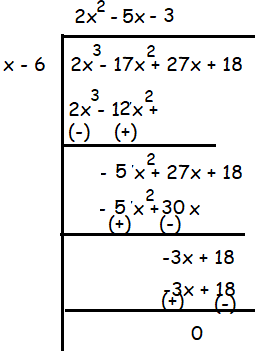FACTORS OF LINEAR EXPRESSIONS
Subscribe to our ▶️ YouTube channel 🔴 for the latest videos, updates, and tips.
Factoring (called "Factorising" in the UK) is the process of finding the factors.
It is like "splitting" an expression as a product of simpler expressions.
The following steps would be useful to factor algebraic expressions.
Step 1 :
Find the largest common divisor for all the terms in the expression
Step 2 :
Divide each term of the expression by the largest common divisor.
Step 3:
Write the quotients inside the parenthesis.
Step 4 :
Write the largest common divisor and the parenthesis together using multiplication.
Example 1 :
Factor :
4x + 8
Solution :
Find the largest common divisors for 4x and 8.
The largest common divisor for 4x and 8 is 4.
Divide 4x and 8 by 4
4x/4 = x
8/4 = 2
Write the quotients x and 2 inside the parenthesis and multiply by the largest common divisor 4.
4(x + 2)
So,
4x + 8 = 4(x + 2)
Example 2 :
Factor :
16a + 64b - 4c
Solution :
Find the largest common divisors for 16a, 64b and 4c.
The largest common divisor for 16a, 64b and 4c is 4.
Divide 16a, 64b and 4c by 4
16a/4 = 4a, 64b / 4 = 16b and 4c / 4 = c
Write the quotients 4a, 16b and c inside the parenthesis and multiply by the largest common divisor 4.
4(4a + 16b - c)
So,
16a + 64b - 4c = 4(4a + 16b - c)
Example 3 :
Factor :
-25x + 15
Solution :
Find the largest common divisors for 25x and 15.
The largest common divisor for 25x and 15 is 5.
Divide 25x and 15 by 5.
25x/5 = 5x
15/5 = 3
Write the quotients 5x and 3 inside the parenthesis and multiply by the largest common divisor 5x.
5(-5x + 3)
So,
-25x + 15 = 5(-5x + 3)
Example 4 :
Factor :
1.5y - 9
Solution :
Find the largest common divisors for 1.5y and 9.
The largest common divisor for 1.5y and 9. is 1.5
Divide each term by 1.5y.
1.5y/1.5 = y
9/1.5 = 6
Write the quotients y and 6 inside the parenthesis and multiply by the largest common divisor 1.5.
1.5(y - 6)
So,
1.5y - 9 = 1.5(y - 6)
Example 5 :
Factor :
4w - 8x + 16y - 32z
Solution :
Find the largest common divisors for 4w, 8x, 16y and 32z.
The largest common divisor 4w, 8x, 16y and 32z is 4.
Divide each term by 4.
4w/4 = w
8x/4 = 2x
16y/4 = 4y
32z/4 = 8z
Write the quotients inside the parenthesis and multiply by the largest common divisor 4.
4(w - 2x + 4y - 8z)
So,
4w - 8x + 16y - 32z = 4(w - 2x + 4y - 8z)
Example 6 :
The volume of a bowling ball can be modelled by the function V(x) = 168 - 28x - 28x2, where x represents the radius of the finger holes in inches. Identify the values of x for which V(x) = 0, and use the graph of factor V(x).

Solution :
V(x) = 168 - 28x - 28x2
= 28(6 - x - x2)
= -28(x2 - x - 6)
Factoring this quadratic polynomial, we get
-28(x2 - x - 6) = 0
(x2 - 3x + 2x - 6) = 0
x(x - 3) + 2(x - 3) = 0
(x + 2)(x - 3) = 0
Equating each factor to 0, we get
x + 2 = 0 and x - 3 = 0
x = -2 and x = 3
So, the required values of x are -2 and 3.
Given the volume and height, find a polynomial expression for the area of the base and dimension in terms of x for each figure.
Example 7 :
V(x) = 2x3 - 17x2 + 27x + 18

Solution :
Given that V(x) = 2x3 - 17x2 + 27x + 18
Since height is given that x - 6
Dividing the cubic polynomial by linear x - 6, we get

By factoring 2x2 - 5x - 3
= 2x2 - 6x + 1x - 3
= 2x(x - 3) + 1(x - 3)
= (2x + 1)(x - 3)
So, the dimensions are (2x + 1) (x - 3) and (x - 6).
Example 8 :
The area of the square is 4x2 + 12x + 9 square units. Which expression represents the length of the side.
a) 3x + 2 units b) 4x + 9 units
c) 2x + 3 units d) 4x + 3 units
Solution :
4x2 + 12x + 9
Factoring this polynomial,
= (2x)2 + 2(2x) (3) + 32
Looks like a2 + 2ab + b2 = (a + b)2
= (2x + 3)2
= (2x + 3) (2x + 3)
So, the side length of the square is 2x + 3 units.
Example 9 :
If the area of the square is (4𝑥2 − 4𝑥 + 1) 𝑐𝑚2, what is the measure of its side?
a.) (−2𝑥 + 1) 𝑐𝑚 b) (4𝑥 − 2) 𝑐𝑚
c) (−4𝑥 + 1) 𝑐𝑚 d) (2𝑥 − 1) cm
Solution :
Area of square = (4𝑥2 − 4𝑥 + 1) 𝑐𝑚2
= (2x)2 - 2(2x) (1) + 12
= (2x - 1)2
= (2x - 1)(2x - 1)
So, the required side length of the square is 2x - 1 units.
Subscribe to our ▶️ YouTube channel 🔴 for the latest videos, updates, and tips.
Kindly mail your feedback to v4formath@gmail.com
We always appreciate your feedback.
About Us | Contact US | Privacy Policy
©All rights reserved. onlinemath4all.com
Recent Articles
-
10 Hard SAT Math Questions (Part - 39)
Dec 11, 25 05:59 PM
10 Hard SAT Math Questions (Part - 39) -
10 Hard SAT Math Questions (Part - 38)
Dec 08, 25 12:12 AM
10 Hard SAT Math Questions (Part - 38) -
SAT Math Practice
Dec 05, 25 04:04 AM
SAT Math Practice - Different Topics - Concept - Formulas - Example problems with step by step explanation

